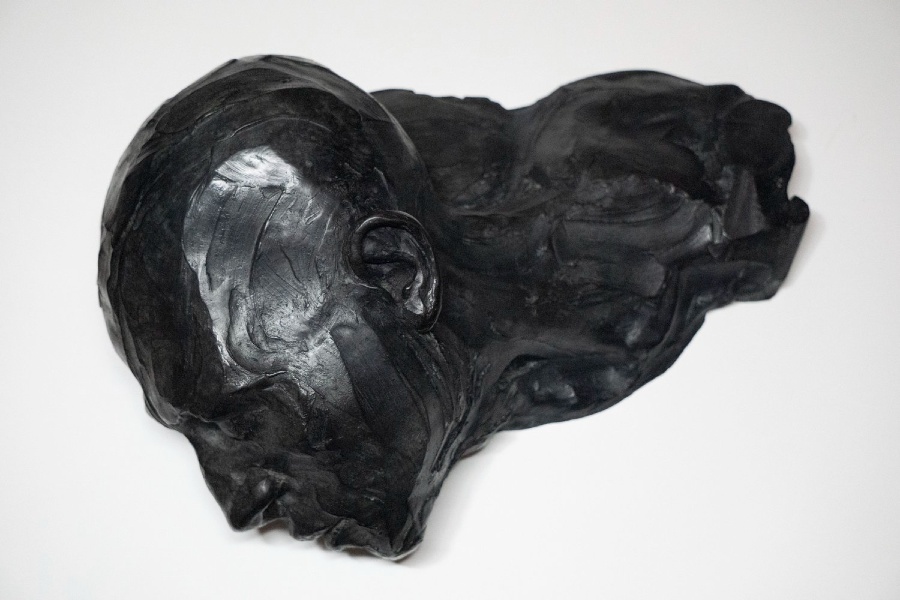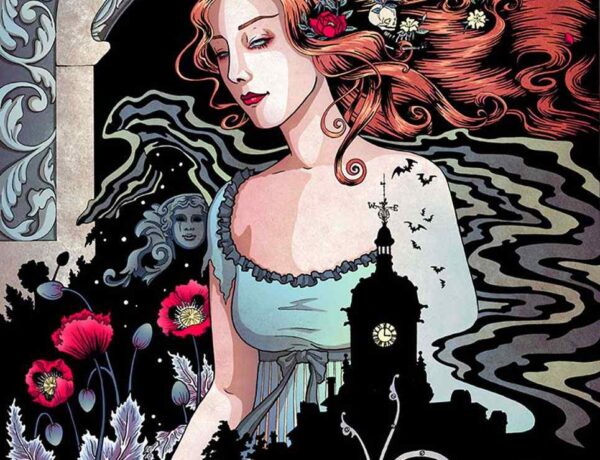Exclusive Interview with Justin M Zielke, People’s Choice Winner, 2020 Beautiful Bizarre Art Prize
Artsy cheerleaders tend to be enthusiastic about the diverse ways that our creative superheroes explore the outer realms of their imaginations. Being respectful of myriad artistic genres and aesthetics, however, doesn’t always ensure that we see things through a lens of logic. Ever gaze at a sculpture and think that you could ‘easily’ create the very same object with your own two hands? Experiencing visions of creative grandeur during a moment of – ahem – delusion is an honest mistake. What separates us from a person who has traversed the path of a sculptor, however? Their highly refined sculpting senses enable them to depict three-dimensional representations of the human experience. Justin M Zielke’s hands are endowed with that magical power.


Sometimes you just have to believe something in order to see it, even if your mind’s eye is the conduit for a visual epiphany. Consider the last time that you were ensconced in a wild, wooded area. You may not have been able to hear the communal exhalation of the forest, but if you paid close enough attention, you could probably feel it. That is what it’s like to properly experience one of Justin M Zielke’s sculptures. His figures evoke a palpable presence. An aura of kinship. They stir within us a sense of relatability, of knowing, and of connection. They hit a nerve within the deepest part of us. Why? Because Justin recognizes that – in order to create a work of art that speaks to the soul – one must heed the resonance of existence.
Want to get hooked on a feeling? For one solitary minute, try clicking the mute button on all of your typical distractions. While gazing at one of Justin’s sculptures, give yourself the gift of mindful appreciation. Zone in on the little details and especially on his mark-making flourishes. Be sure to remind yourself that the soulful essence that you are visually drinking in was formerly an amorphous blob of geologic clay or a fallen tree. That’s when you’ll recognize that what he does is no small undertaking. Justin M Zielke literally raises earthly genetic material from the dead so that it may live on in soulfully charged perpetuity. Ah-ha! The golden moment of inspirational revelation is upon us. Let’s see what Justin has to say about his personal experience as a sculptor of the psyche.
My current work involves diaristic subject matter that dissuades me from using another person’s body. Sculpting a lifelike human is a noble pursuit. My interest peaks in the medium, the mark-making, and the viewer’s imagination.
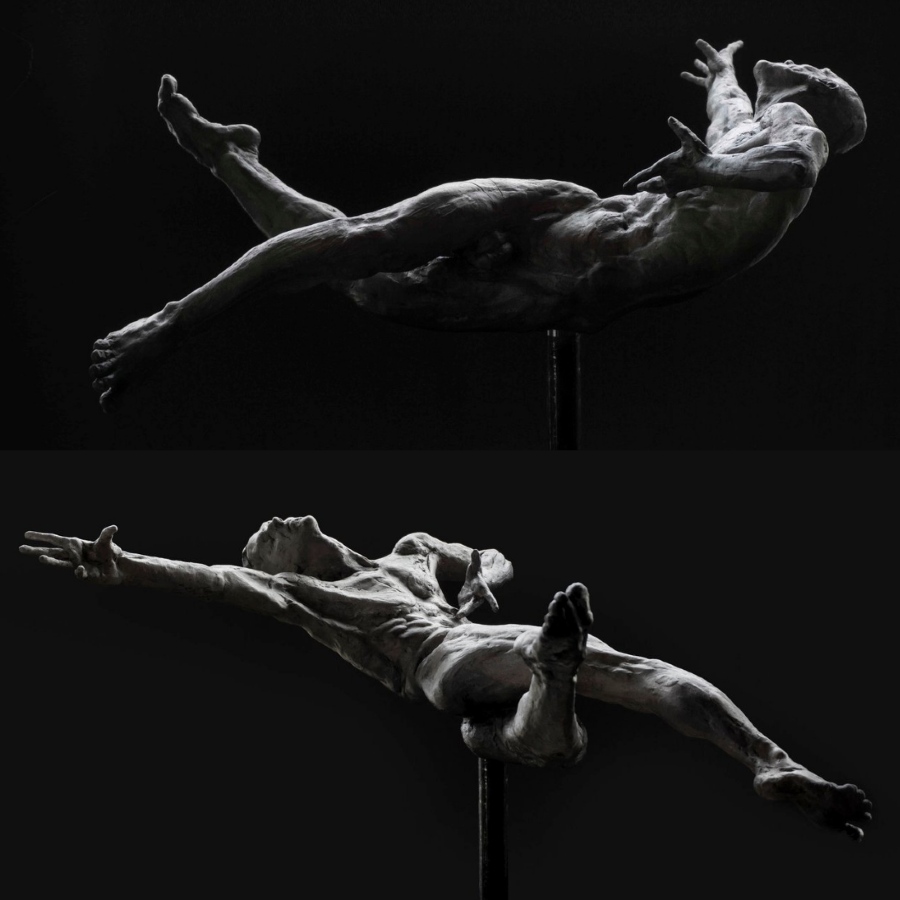
We are so pleased to add your name to our growing list of worthy Beautiful Bizarre Art Prize winners, Justin! A hearty congratulations to you for your fascinating resin and wool sculpture, The Spinning Wheel, which earned you our 2020 People’s Choice Award. Art lovers selected your seated figure as their favorite among an impressive array of finalists. Does that make your achievement feel a little extra special?
Receiving the People’s Choice Award means a great deal to me – it’s truly an honor. Artists from all over the world submit artwork to this competition. The talent, range in mediums, and subject matter is remarkable. Thousands of people actually took time out of their day to vote for a guy who they barely know, based on the virtual lens of my artwork! There are so many artists deserving of this award and I am grateful to represent 2020.
How does a person with a Master’s Degree in animation end up becoming a sculptor? You claim that there are parallels between both creative pursuits, but a little illumination would be greatly appreciated ;)
Most people think of companies like Disney when they hear the word animation. In truth, the field of study equips an artist with skills for many career trajectories. Feature film, UX/UI design, virtual medicine, ballistics, and experimental animation are among the most popular options. In a broad sense, animators understand how objects move in a timeframe, and sometimes, how a person may experience the time given.
My focus was on experimental animation and how a timeline can affect a viewer’s emotion. I studied concept art, anatomy, and acting, all of which gave me the tools to create figurative sculptures and installation art. Concept art is the process of building a world of symbols that enables a feature film character to confront emotional obstacles. Anatomy and acting help relate viewers to another being and guide them through emotions.
So, abstractly, I view my work as a dreamlike still frame that uses symbols to communicate a feeling to a viewer. When you watch a feature film, you’re introduced to elements in a story. Sculpture, on the other hand, displays everything at once. The viewer’s attention and movement around the sculpture is what builds the story.

The Spinning Wheel is a wildly ambitious sculpture, not only in scale but also in concept and execution. It seems like it was truly a labor of love. Was your seated spinner the very first larger-than-life piece that you created?
Yes. Initially, I had no clue that I would be using upwards of 500 lbs (230 kg) of clay to create The Spinning Wheel! It took a bit of time to build up the courage to purposefully break my freshly cast sculpture with a hammer. The fact that it was my first larger than life piece didn’t make it any easier. Trusting in the emotion that you’re trying to express ends up taking precedence over the attachment that you have to the object.
You began working on your seated figure in May of last year. How long did it take to complete?
I made The Spinning Wheel for an exhibition’s deadline, which was at the end of June. I spent 300 hours all together over a 1.5-month time frame.
The true-to-life appearance of The Spinning Wheel didn’t manifest due to the convenience of using a live model. You took the role of muse into your own hands by photographing yourself from various angles while in a seated position. Additionally, you referred to other classical art imagery, myriad hand-cast body parts and old fashioned imagination to bestow your sculpture with sinewy realism. You went to those great lengths, all because you have no access to human models? Exactly how deep into the wild and wooly Kansas boonies is your art studio?
My current work involves diaristic subject matter that dissuades me from using another person’s body. Sculpting a lifelike human is a noble pursuit. My interest peaks in the medium, the mark-making, and the viewer’s imagination. The idea that emerges from a figure interacting with an object is far more important to me than the figure’s likeness, uniqueness, or realistic appearance.
For instance, right now I am carving a figure in wood, and the material is splitting. The longer I’ve carved it, the more it has resembled me. Eventually, the viewer may not see my image as much as the wood naturally splitting a figure. I am chasing after something that I already know to be imperfect, but that imperfection may end up being the focal point. It reflects a very archetypal journey that everyone confronts daily.
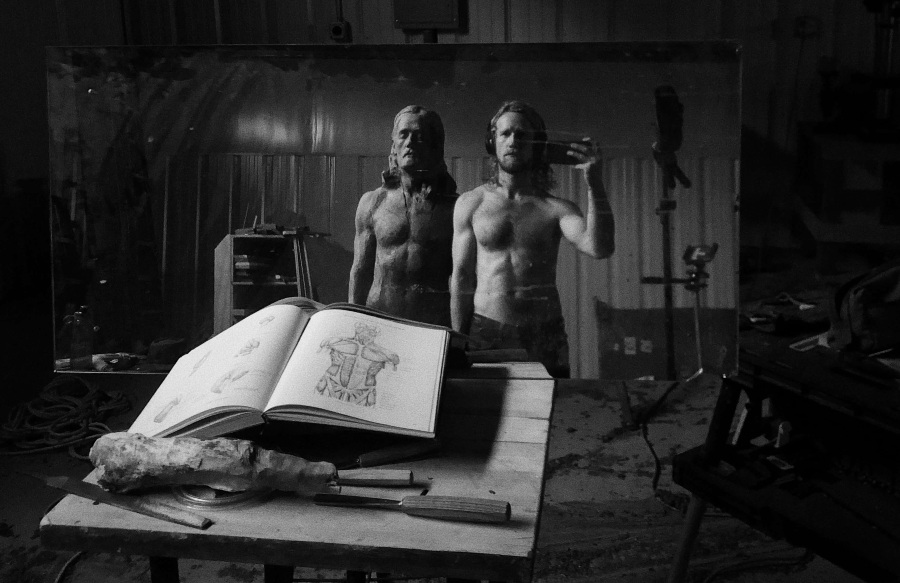

The objects don’t necessarily have a universal emotion attributed to them. They become contextual elements that contribute to a symbolic meaning that is dependent upon the viewer’s interpretation.
You transform fallen trees into handmade charcoal powder which you then mix into your sculptural aqua resin! That’s tres art-geeky, isn’t it?
My interest in wood came from the environment that I live in. There are a lot of rotten, fallen trees and I simply enjoy making use out of something that seems functionless. Two ways that I accomplish that are carving them into figures or making handmade charcoal, which I suspend in casting materials or draw with.
When you decide to commit to a project, it really does seem like you go full throttle. What makes your artistic approach a bit different than that of your contemporaries?
In the traditional sense of sculpting, people aim to depict an emotion or narrative
with an ideal figure. They choose a specific person for their unique qualities that
they believe relates to viewers in a universal sense. I aim for a different result by placing more emphasis on the interaction between a figure and an object.
The objects don’t necessarily have a universal emotion attributed to them. They become contextual elements that contribute to a symbolic meaning that is dependent upon the viewer’s interpretation. My work focuses on the medium and how the nature of that material may further express this indifference. My active pose of a wood torso carved from rotten wood illustrates this concept.

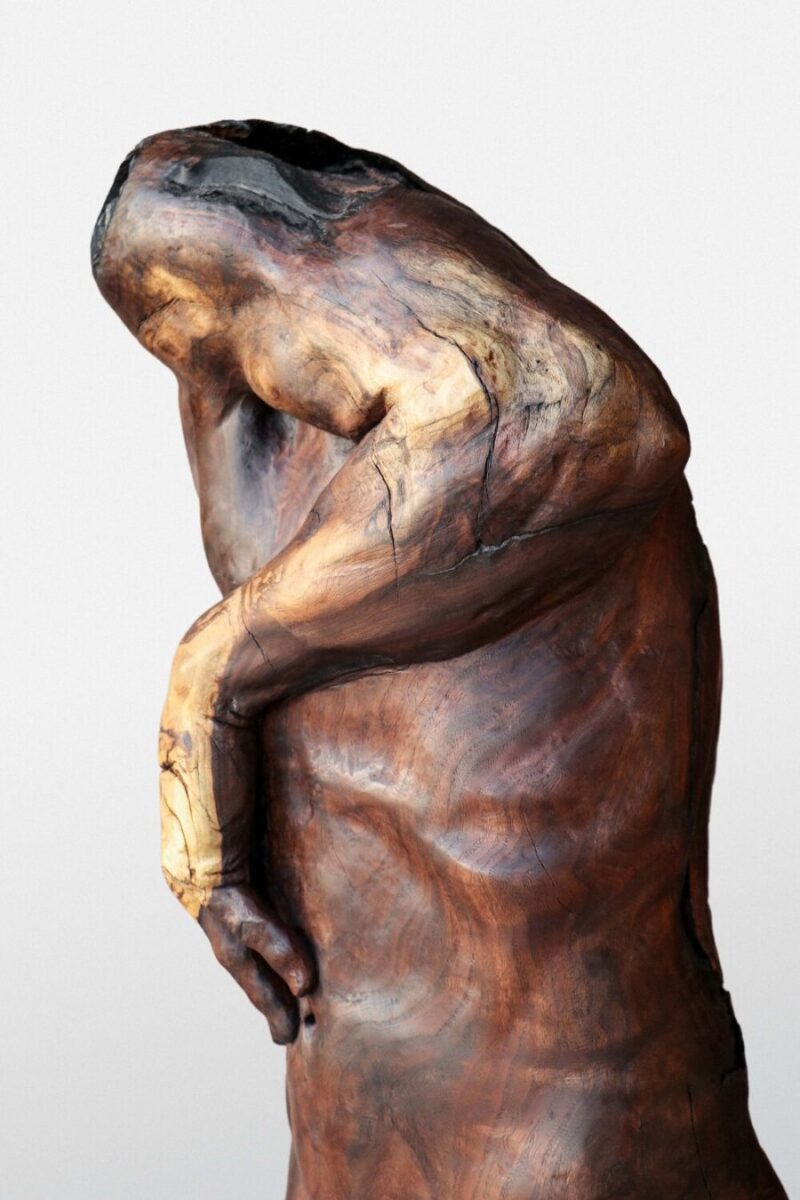
Your DNA seems to be imbued with the Midwestern need to create. It makes perfect sense that you’ve channeled that kinetic energy into your sculpting career. And yet…is it a bit unusual for a salt-of-the-earth Kansas boy to wield a veining tool rather than an ax?
My late Grandpa was a farmer. Those in his profession tend to have ingenious minds for creating functional objects. Some of his tools were so explicitly made for their function; the form becomes beautiful in its unforgiving honesty. Eventually, I would like to expand my work into installations that evolve from this concept.
It’s exciting to discover the perfect creative tool, whether it’s a baseball bat, guitar string, chainsaw or even dental implements. I could refine the tools of my trade or make an honest mark of my emotion with a repurposed tool. I am willing to risk the original idea of a sculpture for the sake of trying something new.
Your initial vision for The Spinning Wheel could have easily resulted in a sculpture with a similar “concept vibe” but a very different execution. In the early days of your project, you intended to create a foam cast and ensconce your seated figure with needle felted wool. Is this indicative of the natural metamorphosis of creative ideas?
If I made my sculpture entirely out of wool, that would have been so cool! I had a lot of ideas for that concept. I wanted to make several sculptures – all out of wool – interacting with one another. All of them were going to be in varying stages of completion. I envisioned one with just feet, a full-body, and an adult’s hand holding their fully formed child. So many ideas emerged, but ultimately, I had to consider expenses and my upcoming deadline.

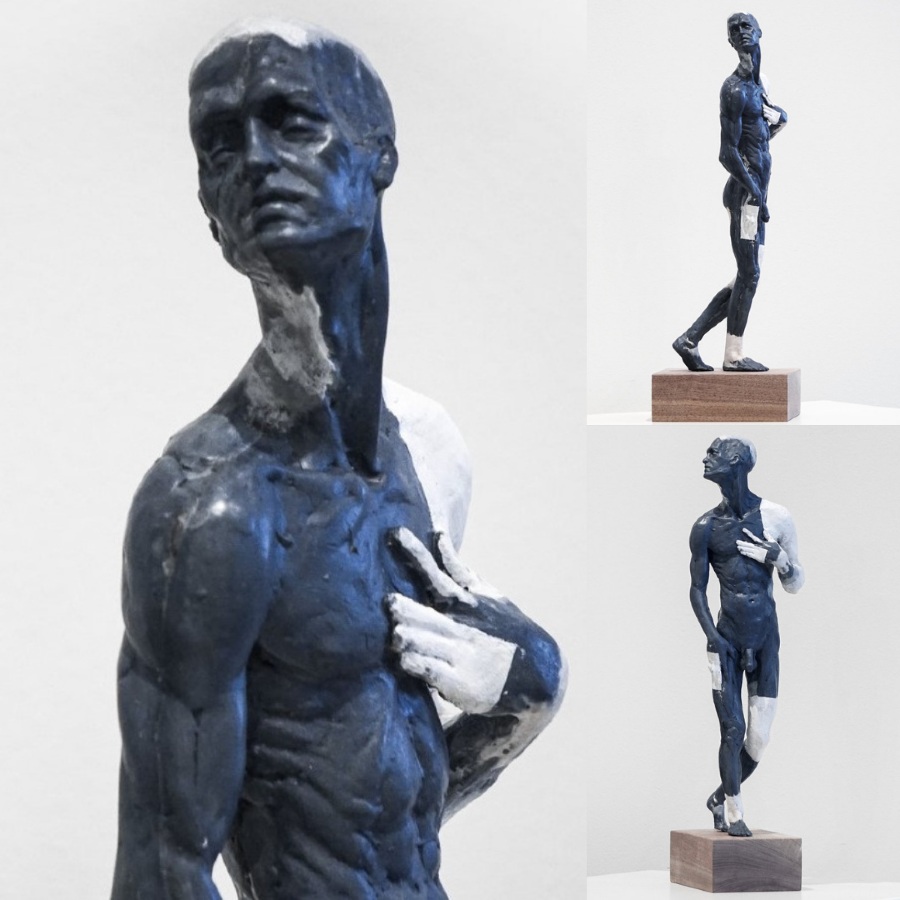
Cast seams appear to be the bane of many a sculptor’s existence. Can’t you just sand them out and happily go about your artful business?
Usually, you can sand seams out and sculpt back into them with casting materials. Sculptures are versatile and can always be fixed. Ultimately, I believe that the broken cavity in The Spinning Wheel ended up triggering a symbol and level of intensity for the viewer, which makes me happy.
Despite the material evolution of your sculpture, you preserved the underlying idea. Your wool spinner seems to be symbolic of the significant labor – as well as the heart and soul – that a person channels into the creation process. The fact that your figure has a woolen interior suggests that every fiber of its being is, quite literally, poured into its work. That’s the interpretive beauty of art, though, isn’t it? One image can summon endless emotions and perspectives.
There are a lot of potential interpretations for The Spinning Wheel. I think a viewer will always see it as something other than my original intention. One may take note of a muscular man with a neutral expression who is spinning wool with an active pose. Another may see a naked figure spinning thread. Or the broken cavern in the figure’s chest that yields a limited source of wool that can be spun. They could imagine that the production of the thread is dependent upon the figure’s labor. Each of these interpretations has significance, and of course, is subject to the unique perspective of each viewer.
There’s a sensation of being too close to someone, as if they could breathe on your neck. You start to treat this person with empathy as you carry on a kinetic conversation.
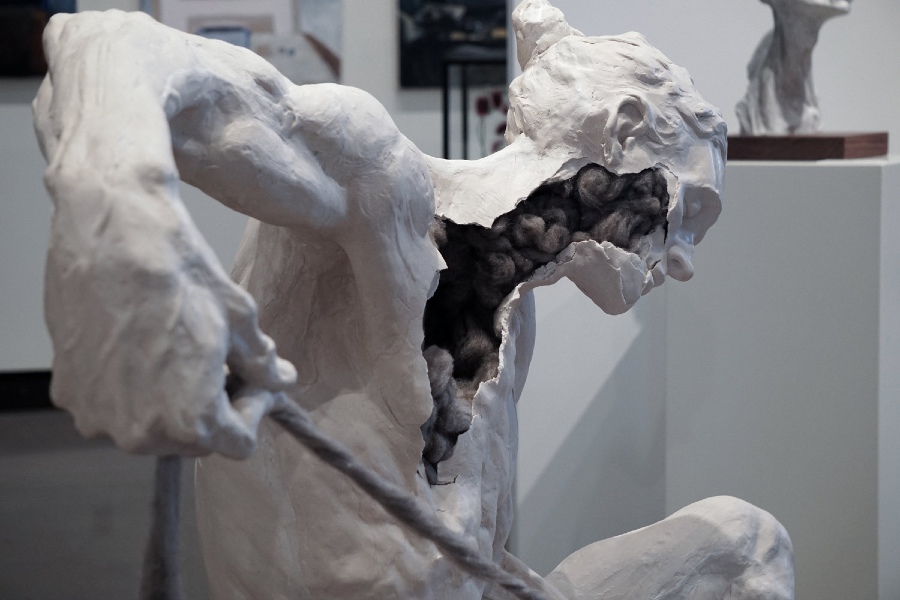
The antique wooden spinning wheel that your figure is seated upon is a focal point of your sculpture. How did that pivotal storytelling device find its way into your narrative?
A lot of anachronistic tools and farming equipment can be found in Kansas. That makes them a natural part of my storytelling process.
You began working on The Spinning Wheel by creating an abstract representation of your figure’s head and limbs using a spool of pliable wire. You twisted loops into the entire length of the metal armature, presumably to help anchor the clay. Do all sculptors begin with this basic underpinning?
It is customary to build an armature for sculptures that are large in scale or have a lot of movement. The armature acts as a scaffold or skeleton to support the weight of the clay. It’s the same as when you extend your arm out for a long period of time. Your shoulder will eventually get tired and need some rest. The idea is to make a sculpture nice and comfy with strong supports where the weight extends past an upright position. If you don’t do that, your sculpture will find a way to get comfy. In other words, expect to walk into your studio the following day and discover that your standing nude has become a reclining nude.
You bulked up your structural skeleton with 550 pounds of clay flesh. Just a month into your project, you shaped and texturized the anatomy of your figure so realistically that you “danced around it like a mystic, thinking that it would begin to breathe”. While surveying what you fleshed out in just four weeks, were you hopped up on creative creationism?
To be honest, it was a little uncanny. At the life-size scale, a sculpture does come to life. You experience the presence of someone in the room. There’s a sensation of being too close to someone, as if they could breathe on your neck. You start to treat this person with empathy as you carry on a kinetic conversation.
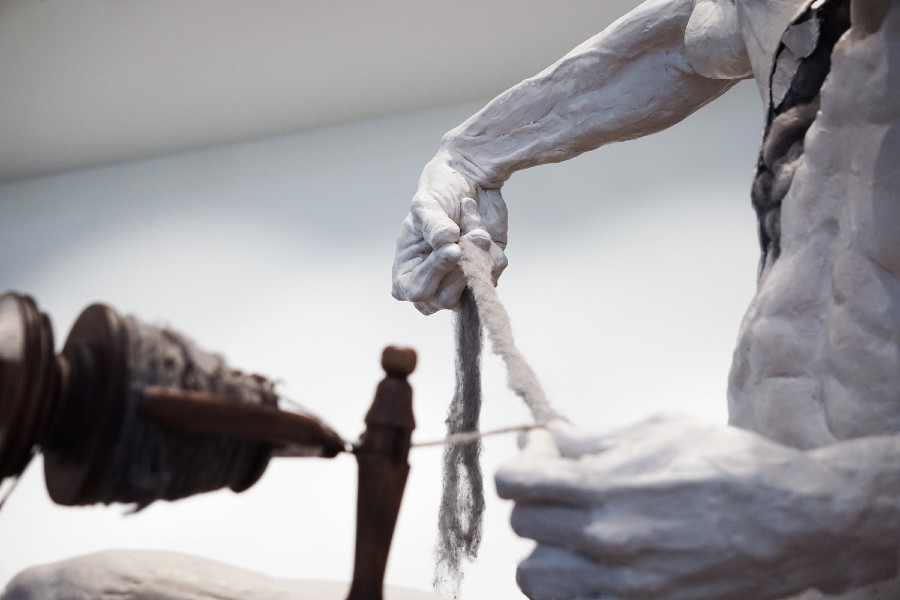
The Spinning Wheel’s sculptural journey continued when you created a hybridized slip-mesh fiberglass cast of your clay figure. You mentioned that this technique can offer far more flexibility to the artist, particularly if they want to render future versions of a sculpture in different materials. If the typical art student had Spinning Wheel aspirations, just how many pints of blood or full-sized organs would they have to sell to make it happen?
I often use materials such as SmoothOn Rebound 25 silicone, AquaResin casting, Laguna EM 217 WED clay, and Chavant Le Beau Touche oil-based clay. There are several options and competitive prices for all of these products, but sculpting is expensive. If you want to make a large sculpture and have no idea what the costs will be, I’m already seeing a red flag.
Sculptures are typically difficult to sell. The difficulty increases exponentially based on the size of the sculpture. I would advise those who are new to the practice to focus on small scale sculptures, first. Find out what kind of expenses are involved in this art form. Learn the process. As you make sales, slowly scale up.
It looks like your earthen spinner got fairly battered after you unsheathed it. Does the slip-mesh fiberglass casting process compromise the structural integrity of a clay sculpture?
Sculptors make a silicone mold of the clay by brushing silicone onto the clay surface. Layers of silicone are added to build up a thickness. The silicone cures and can hold its shape but it maintains some flexibility. A hard shell made of plaster and fiber surrounds the silicone to hold the silicone’s shape. The shell and the silicone are then peeled away from the clay sculpture. The clay is completely removed and either recycled for another work or destroyed. Material – such as resin, wax, or plaster – replaces the clay entirely. Sculptures reinforced with fiberglass are very common, durable, and long-lasting.
In every stage of my life, sawdust has always been nearby.
Where is the clay version of your spinner currently living out its days?
It’s still in the corner of my studio, cracking away. Meanwhile, my finished resin sculpture is currently in storage while waiting to be exhibited in 2021!

Is it becoming more common for contemporary sculptors to exercise greener practices?
I think it’s up to the individual sculptor to seek out green practices. The sculpting process can produce a lot of waste, but surprisingly, almost everything can be recycled! The metal from the armature, the wood from the armature base, and the clay are all recyclable. I use plastic cups and buckets in the silicone process that can easily be cleaned and reused for the next project. In fact, I use the same plastic cups today that I used when I was creating my very first sculpture! Silicone molds can be preserved for future casting. I also use AquaResin for casting, which is eco-friendly and healthier for the sculptor (compared to conventional fiberglass resin).
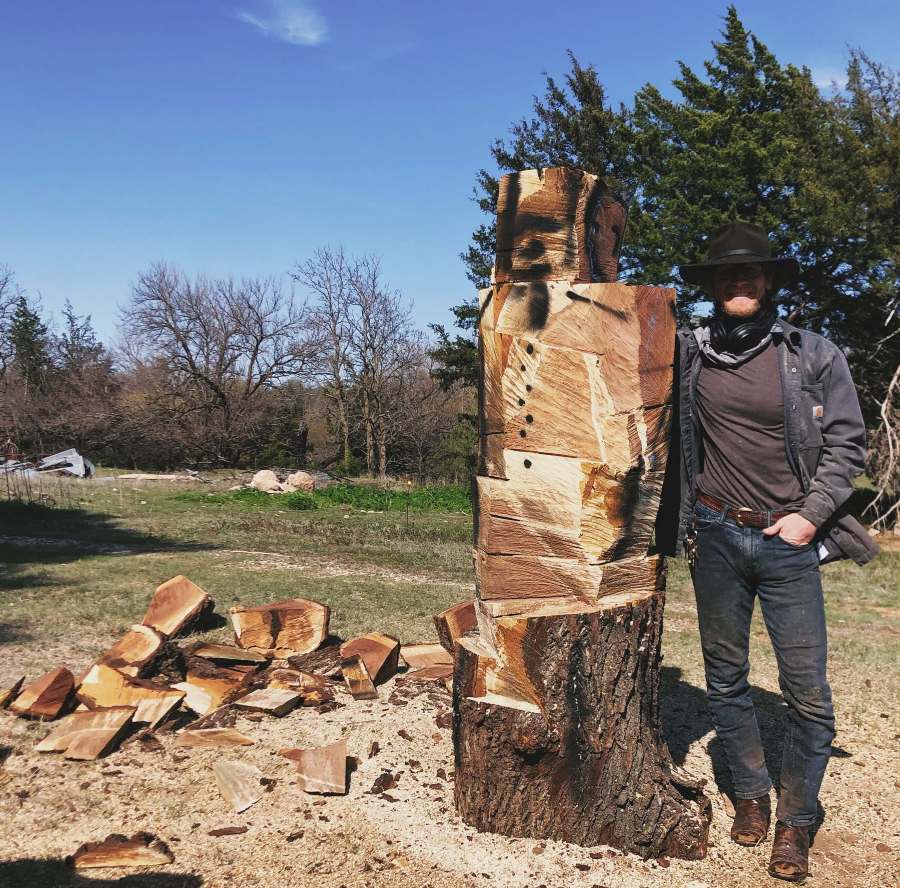
After completing The Spinning Wheel, you created a diverse array of rustic and expressionistic pieces throughout the ensuing months. However, your extreme sculpting juices began to flow yet again in April 2020. That’s when you began the months-long process of whittling the bejeezus out of a ginormous walnut tree trunk – all in an effort to create a life-sized figure of a man. You and your big ideas, ey? Was your project inspired by the large-scale carving success of a contemporary artisan whom you admire?
There are so many fantastic contemporary wood carvers out there. Walpoth, Verginer, and Demetz – among others – are incredibly inspiring.
In every stage of my life, sawdust has always been nearby. I grew up in a woodshop and I was always fascinated with building things. I was probably the only twelve-year-old in Kansas carving a surfboard. Talk about going against the grain!
Since the day I started sculpting, I thought a life-size wood carving would be a great test of my abilities. Plus, with COVID isolation ramping up in Kansas, taking on a long project seemed viable.
It truly is one of the most challenging things that an artist can do. You are carving an impression of life out of an immobile block. With wood, once you make a decision with a chainsaw, an ax, chisels, and a Dremel, it is permanent – you cannot go back. Talk about intense! You have to be fully focused at all times.
With clay, it’s still massively difficult, but you have a little leeway. You can add or subtract. You can press into the surface with the slightest touch of your finger. That said, the molding and casting process is an entirely different beast.
Of all of the projects that I have attempted, wood carving a life-size figure has been the greatest test of my abilities. I’m sure I’ll say the same thing about my next project, though. Each work of art pushes you differently!
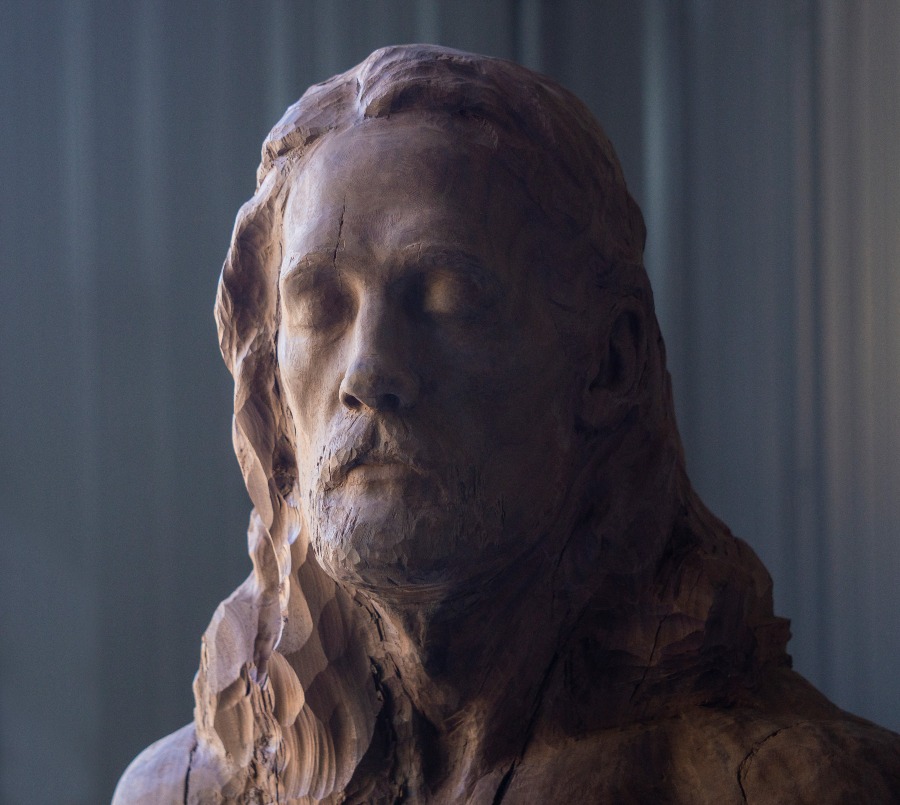
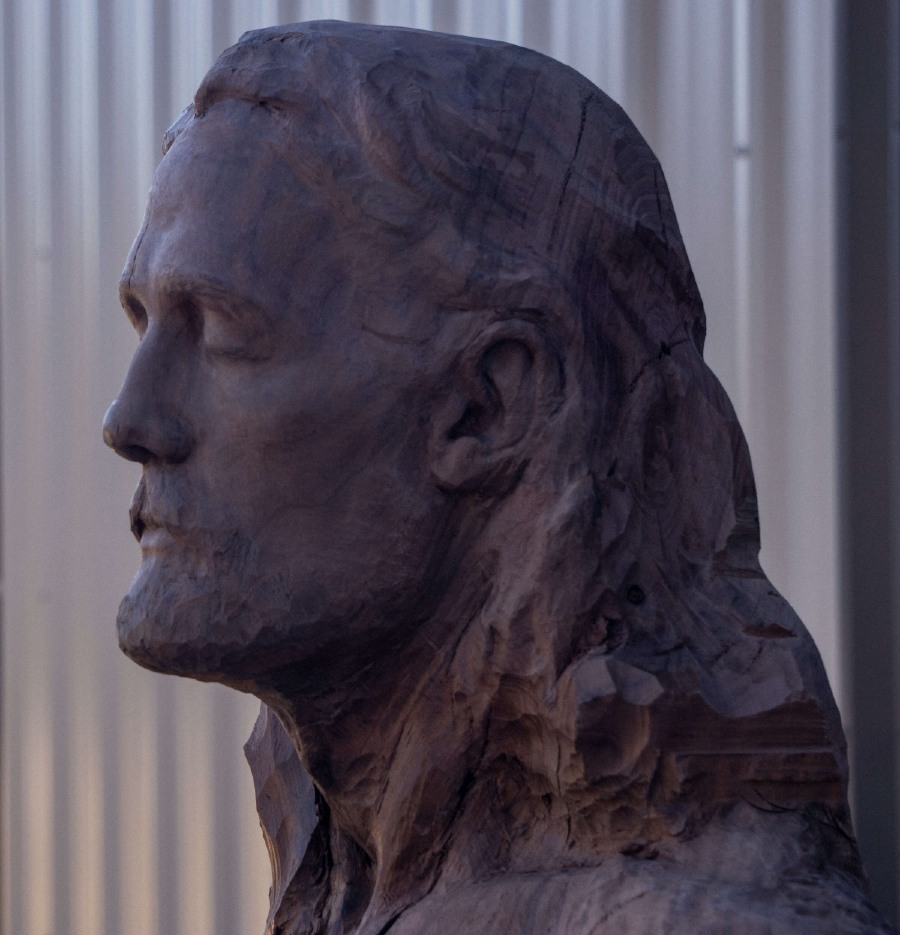
In my perspective, a sculpture is a material vessel that can give the impression of a human while also being a symbol of emotion. The Spinning Wheel has a broken cavity in its chest, which could be considered a mortal wound. I provide viewers with a reason why it is there. That enables their imagination to travel beyond the notion that it is a physically injured human.
Is there a particular advantage to sculpting walnut wood, or is it an aesthetic preference?
There are a lot of fallen walnut trees where I live. I recall clearing the dead trees and seeing movement that gave me the impression of human figures. Using walnut wood is a functional choice, but the grain also happens to be absolutely beautiful. That’s why it still one of the most popular choices in furniture and cabinetry. It has a wide range of reds, yellows, and even some purples. How could I not use this wood, even if it is rotten?
As it turns out, the density of walnut makes it a very difficult wood to carve. Most woodcarvers choose to work with limewood because, compared to walnut, it is a softwood.
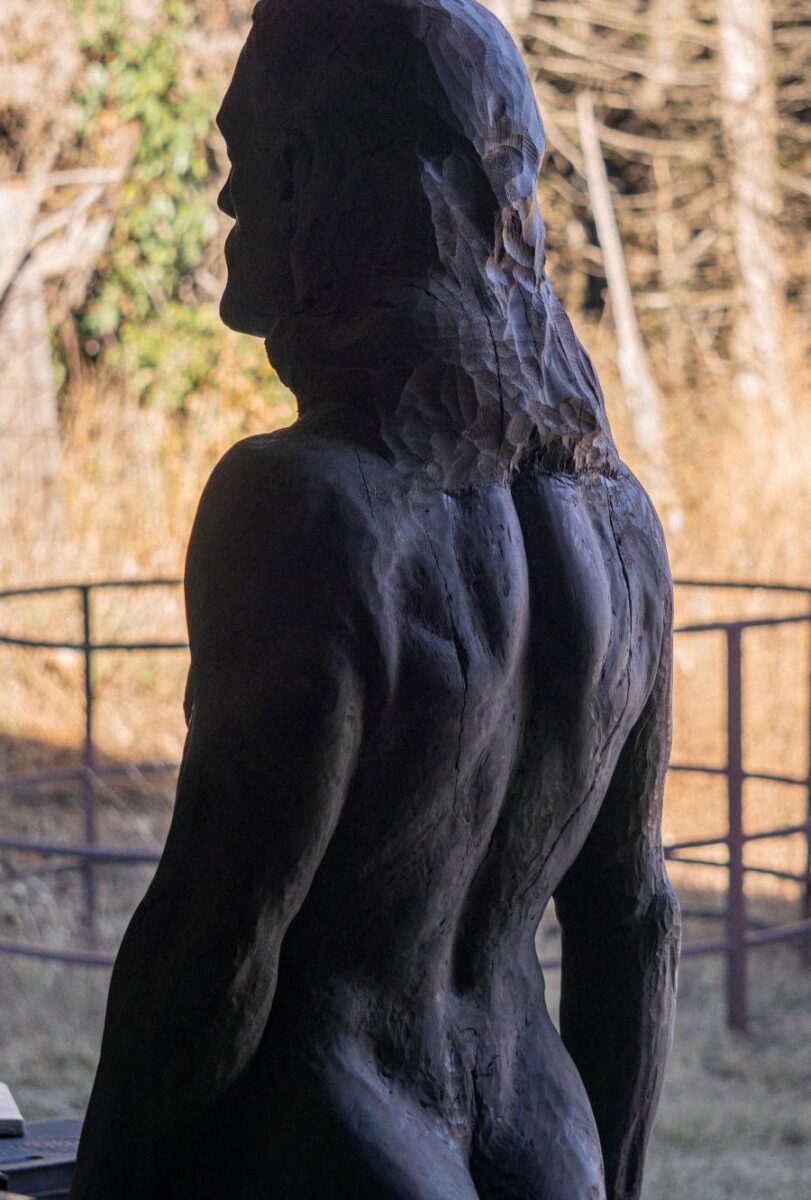
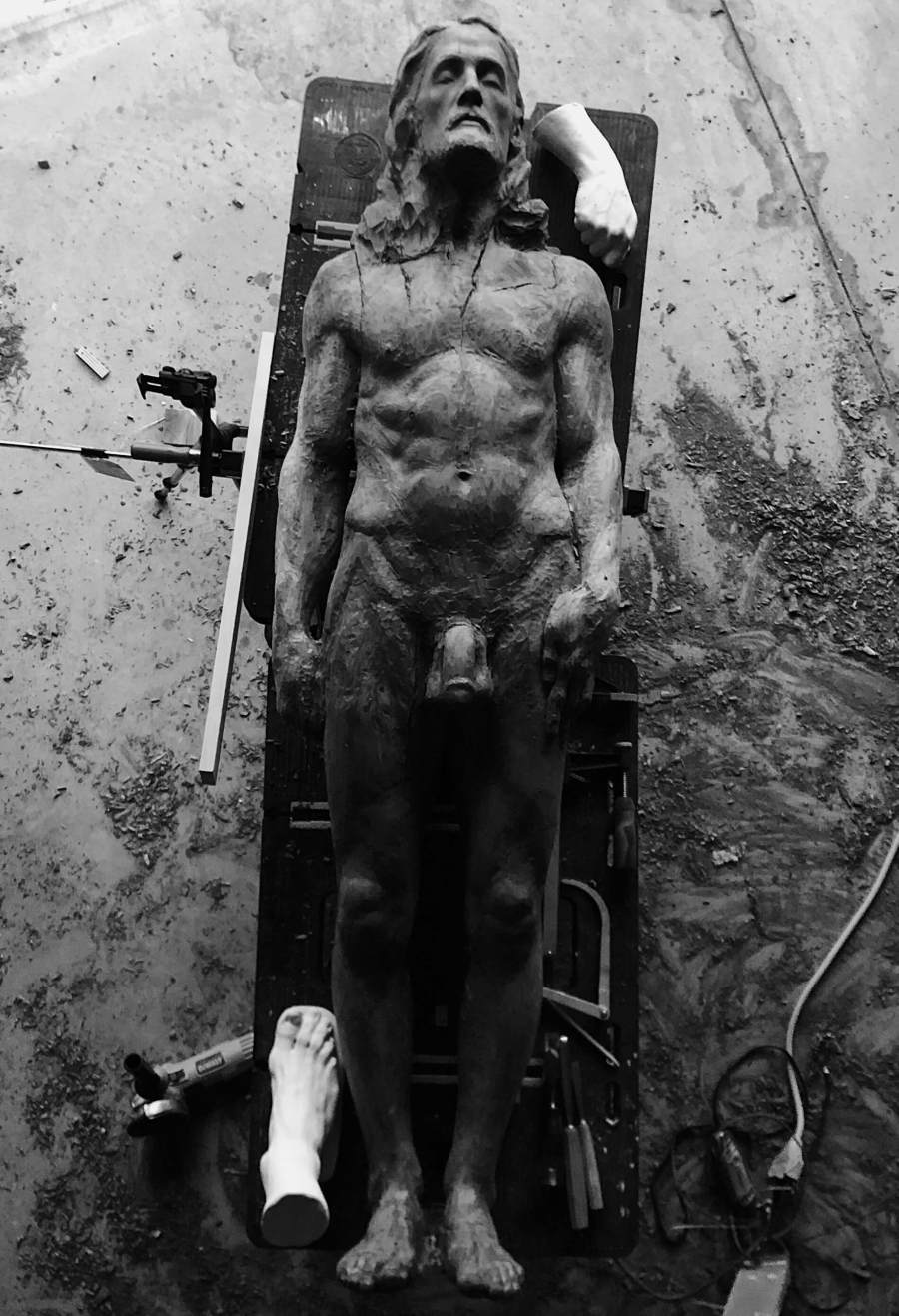
If your life-sized figure were to suffer a mortal chest wound during the carving process, would you just go with the flow?
This is a fundamental question that I ask myself with every work. I see the figure as a subject and symbol that may represent an emotion or meaning. I do not view my sculptures as people or things that can be wounded. Sure, that may seem obvious, but how do people judge a figurative sculpture? Usually, it’s based on how lifelike it is or how realistic it looks. But, nothing is going to look more realistic than a person standing in front of you.
In my perspective, a sculpture is a material vessel that can give the impression of a human while also being a symbol of emotion. The Spinning Wheel has a broken cavity in its chest, which could be considered a mortal wound. I provide viewers with a reason why it is there. That enables their imagination to travel beyond the notion that it is a physically injured human.
I view the sculpting process as a very fluid reflection of emotions, just like we experience our lives. If I were to accidentally gouge the figure in a way that seems abnormal to a lifelike human, I don’t view this as a mistake in the craft. I view this as an opportunity to balance a reason into why this mistake happened for this specific figure. After I identify why this has happened, can I exaggerate this reason for the viewer to immediately see?


It has been utterly fascinating to watch your brother from another forest mother emerge from the grain. Your standing figure wasn’t meant to be a self-portrait. It inevitably became your twin because – while working on it – you gazed at your own reflection as well as individually cast body parts and anatomy illustrations. This process echoes the many steps you took to bring The Spinning Wheel to life. With all of the technology that today’s artists have at their fingertips, do you still feel that creating something the old-fashioned way yields a far more soulful end product?
I am completely pro-traditional and digital! There is a peculiar taboo about fine art sculptors getting into digital work. Oi! It is profoundly ridiculous! Traditional and digital work yield similar experiences for the viewer and the artist. I think every sculptor should explore both because each process has unique qualities that enrich the work. One of the main arguments against digital work is that it yields cheaper reproductions. Hence the overall value is worthless. There was a similar argument against Rodin’s work.
With so much technology at our fingertips, it becomes easier to skip vital steps when learning. When new sculptors have access to technology, they tend to speed through fundamental principles. Think of a painter who teaches themselves how to mix paint traditionally. Compare that to a digital painter who uses a color picker. Another scenario is contrasting a 3D scanning a person and posing them, versus sculpting a figure and physically placing the flow in anatomy. There is an innate lesson to be learned while working with traditional mediums that directly benefits digital processes.

Have you ever walked into a room and felt a human standing there, watching you? That’s how it is for me every morning when I walk into my studio or return from a carving break. It is a truly wild experience, but then you realize that your hands created this uncanny experience.
What kind of engineering/mathematical equations did you have to calculate in order to get your timber twin to stand on its own two feet?
That is such a compliment! Initially, I was concerned about how my sculpture would ever stand on its own feet. I reached out to a few contemporary sculptors for advice since it was my first life-size wood carving. With greater experience and reflection, I realized that the human body is naturally meant to balance when standing upright. However, making a sculpture look human, have rhythm, and a sense of weight is an entirely different story. The rigid skeleton of the body – as well as the skin, muscle, and fat – are all impacted by gravity. Making a piece of wood seem fleshy is quite a process.
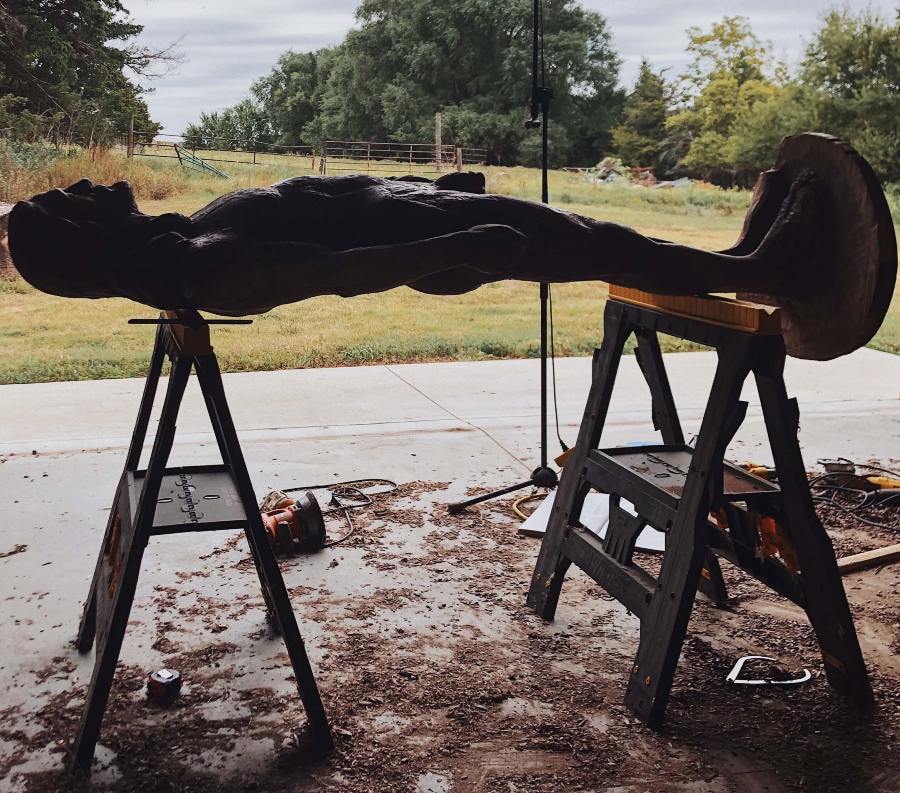
What is it like to be in the presence of a doppleganger-y giant that you crafted with your own two hands?
Have you ever walked into a room and felt a human standing there, watching you? That’s how it is for me every morning when I walk into my studio or return from a carving break. It is a truly wild experience, but then you realize that your hands created this uncanny experience. This presence that you feel is entirely the product of your own time. That feeling is worth every struggle. If a sculptor can sense a person in their studio, the viewer is going to sense a person in a gallery.
With well over half a year of walnut whittling behind you, you’re now in the final stages of bestowing your timber kin with the many hallmarks of realism. Apart from the natural grain already inherent within the wood, every single slope and striation in your sculpture’s skin is achieved with hand tools. Is your personality reflected in your rustically refined mark-making process?
Mark making reveals everything about an artist, whether they want it to or not. It is a very personal experience for an artist and reflects their emotional awareness, intimacy, and even delusion. All art is a peculiar emotional stimulus for how it connects to another human being. Artists offer their works to the viewer earnestly and honestly, rather than for “exhibition”. In the past, people have asked if they could touch the surface of a sculpture. For an artist, that almost seems like a violation of your skin.
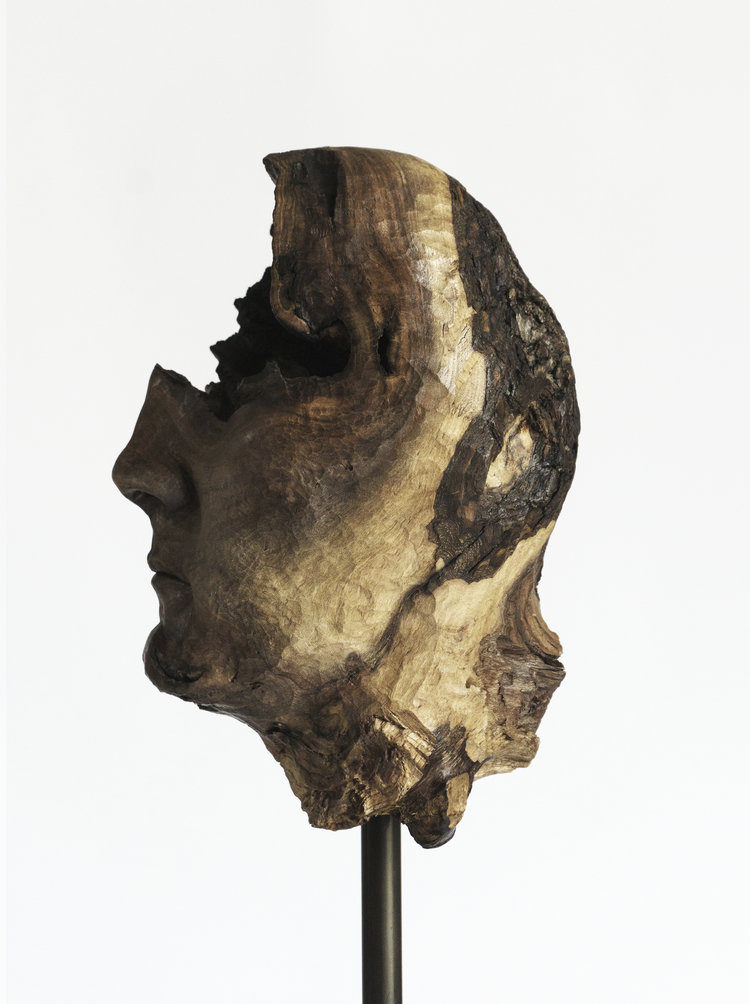
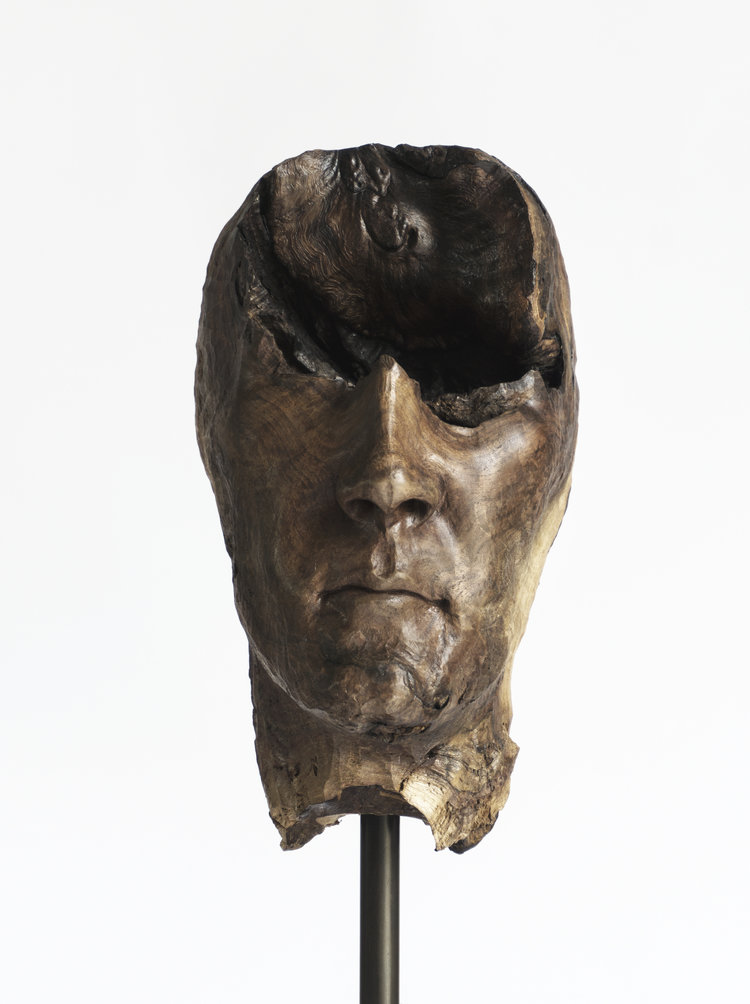
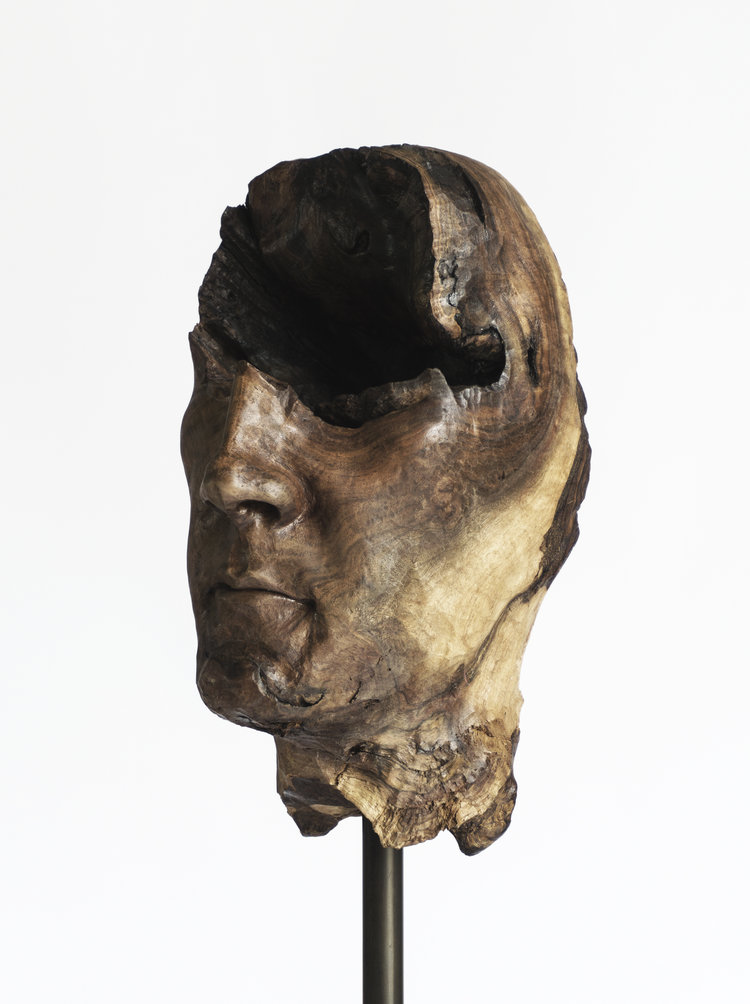
So many steps must be taken in order to bring a sculpture idea out of the sketchbook and into the hallowed halls of a gallery or museum. Is there one aspect of your brainstorming /art manifestation process that you would never ever stray from? What makes it so essential?
For whatever reason, my decision making while creating always feels like impulsive actions that lead to an epiphany. There is a foundational process that I use as a baseline to rely on, but I easily stray away from it to favor nuance. Yet, I look back at the body of work and see fairly unified and progressive decisions. There is one thing that I could never stray from – calling a sculpture complete when my longing to work on it fades. I move on as soon as my desire to work has passed. Once you quench that longing to work, you have recovered whatever it was that inspired you to begin. This also makes it easier to switch mentalities and become more strategic and clinical with prepping the artwork for exhibitions.
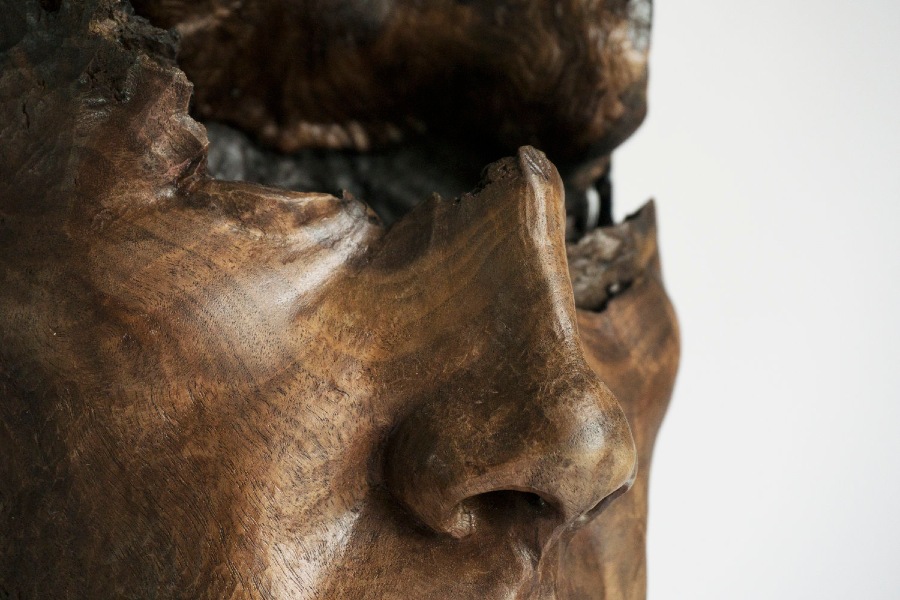
We really appreciate you sharing this conversation with us. Before we let you go, it’s always interesting to hear what inspires artists such as yourself to enter the Beautiful Bizarre Magazine Art Prize. Fire away!
Well, I entered this year’s Beautiful Bizarre Magazine Art Prize because my insanely talented sculptor friend, Brittany Ryan, shared a post about it. By the way, I highly recommend checking her work out!
What do you feel you have gained from this experience?
I live in a rural area of Kansas, which makes it a little difficult for people to discover my artwork. It takes a lot to maneuver big sculptures around the country! I promoted this competition to my social media followers and the result blew me away. Pretty much everyone I knew shared it, which ended up helping me earn this award. Of the 17,000 votes that were recorded, I’m not sure how many votes I got internationally, but I am certain that a vast majority of them were from Wichita, Kansas, which makes me damn proud!
Lastly, would you recommend and encourage others to enter the Beautiful Bizarre Magazine Art Prize? If so, why?
Do you love your art? Do you want your art to be seen? I don’t care who you are, or how good YOU think your art is. It is always worth promoting your work so that others can see it. At the end of the day, it is an emotion that you are creating for yourself that you hope to communicate with others.
